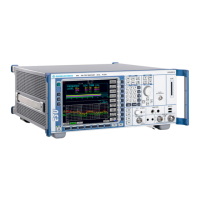Operating Manual 1302.6163.12 - 03 4.93
R&S ESU Instrument Functions
IF Spectrum Analysis Mode
VIEW
The VIEW softkey freezes the current contents of the trace memory and displays it.
For further information refer to the descriptions in section “Receiver Mode” – “VIEW”
on page 4.72.
BLANK
The BLANK softkey activates the blanking of the trace on the screen.
Remote command: DISP:WIND:TRAC OFF
MIN HOLD
The MIN HOLD softkey activates the min hold mode for the trace. R&S ESU saves
for each scan the smallest of the previously stored/currently measured values in the
trace memory.
This function is useful e.g. for making an unmodulated carrier in a composite signal
visible. Noise, interference signals or modulated signals are suppressed by the min
hold function whereas a CW signal is recognized by its constant level.
Remote command: DISP:WIND:TRAC:MODE MINH
AVG MODE
LOG | LIN
The AVG MODE LOG/LIN softkey selects logarithmic or linear averaging for the log-
arithmic level display mode.
Remote command: CALC:MATH:AVER:MODE LIN
With logarithmic averaging, the dB values of the display voltage are averaged. With
linear averaging the level values in dB are converted into linear voltages or powers
prior to averaging. Voltage or power values are averaged or offset against each
other and reconverted into level values.
For stationary signals the two methods yield the same result.
Logarithmic averaging is recommended if sinewave signals are to be clearly visible
against noise since with this type of averaging noise suppression is improved while
the sinewave signals remain unchanged.
For noise or pseudo-noise signals the positive peak amplitudes are decreased in
logarithmic averaging due the characteristic involved and the negative peak values
are increased relative to the average value. If the distorted amplitude distribution is
averaged, a value is obtained that is smaller than the actual average value. The dif-
ference is -2.5 dB.
2.5 dB
Amp litude
Probability d istrib ution
Amp litude distribution
(after avera ging)
Am p litude distribution
(without averag in g)

